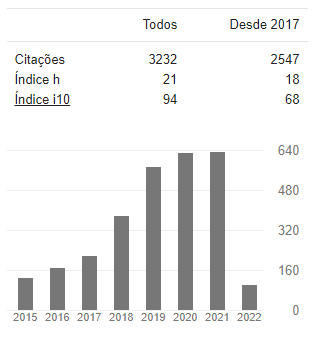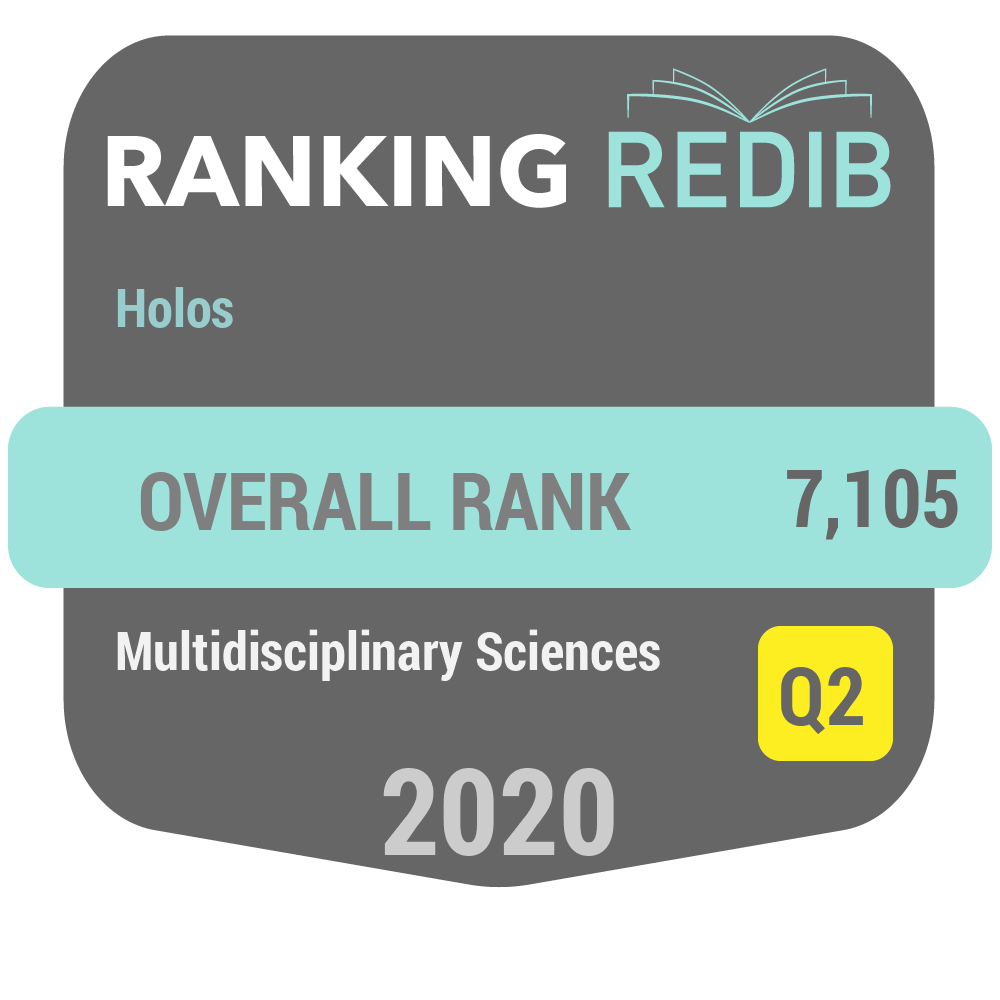ANALYSIS OF WELL-BEING IN OECD COUNTRIES THROUGH STATIS METHODOLOGY
DOI:
https://doi.org/10.15628/holos.2016.5003Palavras-chave:
Principal Component Analysis, STATIS methodology, Three-way data methods, well-being indicatorsResumo
This paper presents the main concepts and results of Data Analysis aims to analyze the evolution of some developed countries and also of some emerging countries that are members of the Organisation for Economic Co-operation and Development (OECD) in what concerns some indicators or variables of well-being during the period 2011-2015, through the STATIS (Structuring Three-way data sets in Statistics) methodology. This methodology allows to analyze the presence of a common structure in several data tables obtained over time, to identify the differences and similarities along the period of time under study and according to well-being indicators included in the “Your Better Life Index” of the OECD, and to analyze the trajectories of the countries.
Downloads
Referências
ABDI, H., FRENCH, R., ORANGE, J.B., WILLIAMS, L.J. A tutorial on Multi-Block Discriminant Correspondence Analysis (MUDICA): A new method for analyzing discourse data from clinical populations. Journal of Speech, Language, and Hearing Research, v.53, n.5, p. 1372-1393, 2010.
ABDI, H., WILLIAMS, L.J., VALENTIN, D., BENNANI-DOSSE, M. STATIS and DISTATIS: optimum multitable principal component analysis and three way metric multidimensional scaling. WIRES Computational Statistics, v.4, n.2, p. 124-167, 2012.
ACAR, E., YENER, B. Unsupervised Multiway Data Analysis: A Literature Survey. Knowledge and Data Engineering, IEEE Transactions, v.21, n.1, p. 6-20, 2009.
ALMEIDA, A.M. Metodologia STATIS Dual. Aplicação a dados sobre Infertilidade. Master thesis-Universidade do Porto, Porto,Portugal, 2012.
AMENDOLA, A., CAROLEO, F.E., COPPOLA, G. Regional Disparities in Europe. The European Labour Market, p. 9–31, 2006.
BOUROCHE, J. Analyse des données ternaires: la double analyse en composantes principales. Doctoral dissertation-Université de Paris, Paris, 1975.
BRÁS, P.C. Estudo da Evolução do Setor da Construção em Portugal recorrendo à Metodologia Statis. Master thesis-Universidade do Porto, Portugal, 2012.
CHAYA, C., PEREZ-HUGALDE, C., JUDEZ, L., WEE, C.S., GUINARD, J.X. Use of the STATIS method to analyze time-intensity profiling data. Food quality and preference, v.15, n.1, p. 3-12, 2004.
COQUET, R., TROXLER, L., WIPFF, G. The STATIS method: Characterization of Conformational States of Flexible Molecules from Molecular Dynamics Simulations in Solution. Journal of Molecular Graphics, v.14, p. 206-212, 1996.
DERKS, E.P.P.A., WESTERHUIS, J.A., SMILDE, A.K., KING, B.M. An introduction to multi-block component analysis by means of a flavor language case study. Food Quality and Preference, v.14, p. 497–506, 2003.
ESCOFIER, B., PAGÉS, J. Multiple factor analysis (AFMULT package). Computational Statistics & Data Analysis, v.18, n.1, p. 121-140, 1994.
ESCOUFIER, Y. Le Traitement des Variables Vetorielles. Biometrics, v.29, p. 751-760, 1973.
ESLAMI, A., QANNARI, E.M., KOHLER, A., BOUGEARD, S., Analyses factorielles de données structurées en groupes d’individus. Journal de la Société Française de Statistique, v.3, n.154, p. 44-57, 2013.
FIGUEIREDO, A., FIGUEIREDO, F., MONTEIRO, N., STRAUME, O. Restructuring in privatised firms: A Statis approach. Structural Change and Economic Dynamics, v.23, p. 108-116, 2012.
GONÇALVES, G.S. Análise da Evolução das Actividades Económicas em Portugal através da Metodologia Statis. Master thesis-Faculadade de Economia-Universidade do Porto, Porto, 2010.
GONZÁLEZ, P., LERA, L., MONTERO, M. Caracterización del Consumo de Energía Eléctrica en Función del Tiempo: Un Enfoque Multivariado. Revista Investigación Operacional, v.26, n.1, 2005.
GOWER, J.C. Generalized procrustes analysis. Psychometrika, v.40, n.1, p. 33–51, 1975.
KOLDA, T.G., BADER, B.W. Tensor decompositions and applications. SIAM Review, v.51, n.3, p. 455-500, 2009.
L’HERMIER DES PLANTES, H. Structuration des tableaux à trois indices de la statistique. Thèse de 3 ème cycle-Université de Montpellier, Paris, 1976.
LAVIT, C., Analyse conjointe de tableaux quantitatifs. Editions Masson, 1988.
LAVIT, C., ESCOUFIER, Y., SABATIER, R., TRAISSAC, P. The ACT (STATIS method), Computational Statistics & Data Analysis, v.18, p. 97-119, 1994.
LE DIEN, S., PAGÉS, J., Hierarchical multiple factor analysis: Application to the comparison of sensory profiles. Food Quality and Preferences, v.14, p. 397–403, 2003.
LOURENÇO, C. Analysis of European Countries’ Vulnerabilities through Statis Methodology. Master thesis-Universidade do Porto-Porto, 2013.
OECD. How’s Life? 2013: Measuring Well-being. OECD Publishing, Paris, 2013, retrieved from http://dx.doi.org/10.1787/9789264201392-en
OECD. OECD.Stat, 2015, retrieved from http://stats.oecd.org
OECD. OECD Better Life Index, 2016, retrieved from http://www.oecdbetterlifeindex.org/
QANNARI, E.M., COURCOUX, P., VIGNEAU, E. Common components and specific weights analysis performed on preference data. Food Quality and Preference, v.12, n.5, p. 365-368, 2001.
RIVADENEIRA, F.J. Analysis of OECD Countries Well-being through Statis Methodology. Master thesis-Faculdade de Economia-Universidade do Porto-Porto, August 2016, retrieved from https://sigarra.up.pt/reitoria/pt/pub_geral.show_file?pi_gdoc_id=778600
SABATIER, R., VIVIEN, M. A new linear method for analyzing four-way multiblocks tables: STATIS-4. Journal of Chemometrics, v.22, p. 399-407, 2008.
SMILDE, A., WESTERHUIS, J., BOQUÉ, R. Multiway multiblock component and covariates regression models. Journal of Chemometrics, v.14, p. 301–331, 2000.
Social Progress Imperative. Create a Social Progress Index, 2016, Retrieved from http://www.socialprogressimperative.org/create-an-index/
STANIMIROVA, I., WALCZAK, B., MASSART, D.L., SIMEONOV, V., SABY, C.A., DI CRESCENZO E. STATIS, a three-way method for data analysis. Application to environmental data. Chemometrics and Intelligent Laboratory Systems, v.73, n.2, p. 219-233, 2004.
VIVIEN, M., SUNE, F. Two four-way multiblock methods used for comparing two consumer panels of children. Food quality and preference, v.20, n.7, p. 472-481, 2009.









































